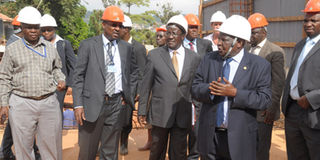High rental costs stifle private sector - expert

NSSF Board Chairman, Mr Vincent Ssekono (C) with NSSF Managing Director, Richard Byarugaba (2nd L) and Mr Henry Ssentoogo, Lead Project Consultant (2nd R), together with other NSSF board members inspect the Pension Towers Project. FILE PHOTO
Years of unstable investments into modern commercial real estate development are partly responsible for the uncompetitive rental rates in Kampala and if left unattended to, will curtail faster private sector growth, William Henry Ssentoogo, a real estate development expert has advised.
Ssentoogo, a Senior Partner with Ssentoogo&Partners, who was leading the National Social Security Fund (NSSF) board on a tour of Pension Towers Project on Lumumba Avenue, said Kenya, continues to out-compete Uganda as a business hub, partly because of their low rental rates.
“You have no idea by how much the Ugandan economy would benefit from hosting some of these huge multinationals. However, we can bring down significantly our rental costs if we address the supply gap. We need to see organisations and if need be, government, injecting money into huge commercial and rental projects such as Pension Towers,” he said.
Pension Towers is owned by NSSF. The first phase of the construction that comprised of excavation works, laying the foundation and construction of four basement floors, to be used as parking for 500 cars, is on schedule and due for handover by Roko Construction, in September this year.
The second phase shall consist of construction of 3 podium floors, as well as a 3 tower structure, comprising of two-8 storey towers and the main 25 storey tower. Mr Vincent Ssekoono, the NSSF Board Chairman told the board that the bidding process for the second phase will commence in the third quarter.
Ssekoono, who said he was impressed by the progress of the works, defended the project, which in 2008 came under attack from sections of the public and politicians over altered designs and subsequently increased costs.
The initial plan consisted of 3 towers of 12 storeys and was estimated to cost $24 million.
However, the plans were modified into a 3 storey structure with 2 storeys of 12 towers and a main tower of 24 storeys. The new design would cost $75 million- a 3 fold increase.
“The old designs which had been in existence for over 8 years, were overtaken by events. The increased demand for modern office space in the city centre meant that the fund would make more returns by putting up a much bigger project, with more rentable space,” he said, adding: “whereas the costs increased by 3 times, projected annual incomes would grow six times from $1.32 million to $10.5 million.”
Mr Ssekono said the building will probably be the most modern commercial building, with intelligent and state-of-the-art systems such as access control, security, fire control and elevators.
According to a recent report by Knight Frank Uganda, a leading property manager, unlike Nairobi which has enjoyed uninterrupted real estate developments over the last 2 decades- at an average rate of 80,000 square metres per annum, Kampala has only been growing at a dismal average of 40,000 square metres annually, leading to high prices as well as giving landlords too much grip on the real estate market.
“The challenge in Tanzania and Uganda is to improve and broaden the delivery system while lowering its price. Markets really do work once the pendulum swings in the tenant’s direction. When that happens, developers will become fierce cost cutters to meet their return expectations,” reads the report in part.
According to the report, on average, a square metre of office space, ranges between US$14-17 in Kampala, US$15-18 in Dar s Salaam and only US$6-7 in Nairobi. This is however an improvement from 5 years ago, when similar space went for US$20 in Kampala and US$25-30 in Dar es Salaam.
These high costs are partly associated with the high costs of construction. According to the same report, it costs about US$400 to put up a square metre of office space in Nairobi, US$520 in Dar es Salaam and US$640 in Kampala.
The Ugandan situation is made even more serious by the high and rising cost of energy, particularly in air conditioned buildings and tall towers with old lifts as well as the cost of parking or lack of the same.




